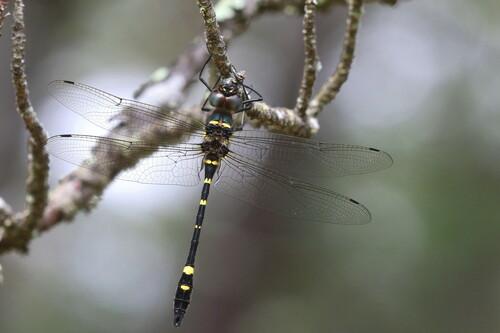Plants and Animals
Macromia alleghaniensis Alleghany river cruiser
Key Characteristics
North American dragonflies in the genus Macromia are dark brown or black. Species within the genus can be distinguished by the presence or absence of yellow markings on the thorax and yellow rings on abdominal segments 2 and 7. The adult male Allegheny river cruiser has a complete yellow basal ring on abdominal segment 7 and a yellow ring on abdominal segment 2 that is interrupted dorsally. Macromia alleghaniensis is 2.8 inches long with brilliant green eyes.
Status and Rank
US Status: No Status/Not Listed
State Status: T - Threatened (legally protected)
Global Rank: G4 - Apparently secure
State Rank: SNR - Not ranked
Occurrences
| County | Number of Occurrences | Year Last Observed |
|---|---|---|
| Cass | 1 | 2019 |
| Jackson | 1 | 2023 |
Information is summarized from MNFI's database of rare species and community occurrences. Data may not reflect true distribution since much of the state has not been thoroughly surveyed.
Habitat
Allegheny river cruisers are found near slow flowing rivers and streams. In Michigan, they have been collected from shallow creeks with nearby seeps, surrounded by forbs, sedge hummocks, cattails, and shrubs.
Natural Community Types
- Headwater stream (1st-2nd order), riffle
- Headwater stream (1st-2nd order), run
For each species, lists of natural communities were derived from review of the nearly 6,500 element occurrences in the MNFI database, in addition to herbarium label data for some taxa. In most cases, at least one specimen record exists for each listed natural community. For certain taxa, especially poorly collected or extirpated species of prairie and savanna habitats, natural community lists were derived from inferences from collection sites and habitat preferences in immediately adjacent states (particularly Indiana and Illinois). Natural communities are not listed for those species documented only from altered or ruderal habitats in Michigan, especially for taxa that occur in a variety of habitats outside of the state.
Natural communities are not listed in order of frequency of occurrence, but are rather derived from the full set of natural communities, organized by Ecological Group. In many cases, the general habitat descriptions should provide greater clarity and direction to the surveyor. In future versions of the Rare Species Explorer, we hope to incorporate natural community fidelity ranks for each taxon.
Management Recommendations
The Allegheny river cruiser has been recorded at very few sites in Michigan. Surveys are needed to determine its abundance and distribution.
Active Period
Flight from first week of June to fourth week of August
Survey Methods
Males patrol from 8 AM to 5 PM.
Aerial net
Survey Period: From first week of June to fourth week of August
Time of Day: Daytime
Survey Method Comment: Adults
References
Survey References
- Dunkle, S.W. 2000. Dragonflies through Binoculars. Oxford University Press, Oxford. 266pp.
- Paulson, D. 2011. Dragonflies and Damselflies of the East. Princeton University Press, Princeton, New Jersey.
Technical References
- Craves, J.A. & O’Brien, D.S. 2015. Macromia alleghaniensis (Odonata: Macromiidae): New For Michigan, with Clarifications of Northern Records. The Great Lakes Entomologist 48(3).
- Dunkle, S.W. 2000. Dragonflies through Binoculars. Oxford University Press, Oxford. 266pp.
- Paulson, D. 2011. Dragonflies and Damselflies of the East. Princeton University Press, Princeton, New Jersey.


